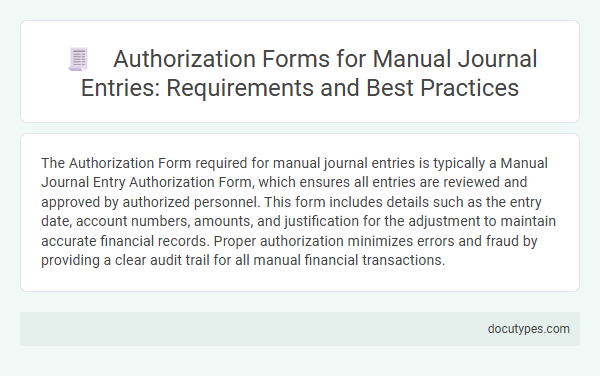The Authorization Form required for manual journal entries is typically a Manual Journal Entry Authorization Form, which ensures all entries are reviewed and approved by authorized personnel. This form includes details such as the entry date, account numbers, amounts, and justification for the adjustment to maintain accurate financial records. Proper authorization minimizes errors and fraud by providing a clear audit trail for all manual financial transactions.
Introduction to Authorization Forms for Manual Journal Entries
Authorization forms for manual journal entries ensure proper approval and control over financial transactions. These forms typically require details such as the transaction amount, reason for entry, and necessary signatures from authorized personnel. You must submit the correct authorization form to maintain compliance and enhance audit trails in your accounting processes.
Importance of Authorization in Financial Documentation
Authorization forms for manual journal entries typically require approval from designated finance personnel or management to ensure accuracy and accountability. These forms document the review process, serving as evidence that the transaction complies with internal controls and company policies.
The importance of authorization in financial documentation lies in preventing errors, fraud, and unauthorized transactions. Proper authorization maintains the integrity of financial records, supports audit trails, and reinforces regulatory compliance.
Key Regulatory Requirements for Authorization Forms
Authorization forms for manual journal entries must comply with key regulatory requirements to ensure accuracy, accountability, and compliance in financial reporting. These forms serve as documented approval for adjustments, minimizing risks of errors and fraud within accounting processes.
- Compliance with SOX (Sarbanes-Oxley Act) - Authorization forms must include signatures from designated approvers to meet internal control standards mandated by SOX.
- Control over Access and Approval Levels - Forms should specify different authorization tiers based on transaction amounts to enforce segregation of duties.
- Audit Trail Requirements - Authorized manual journal entries must provide a clear, time-stamped record to support auditability and regulatory inspections.
Essential Components of Authorization Forms
What authorization form is required for manual journal entries? Authorization forms for manual journal entries must include key components to ensure accuracy and accountability. Essential elements include the preparer's details, approval signatures, and a clear description of the transaction.
Roles and Responsibilities in the Authorization Process
Authorization forms are critical for ensuring the accuracy and compliance of manual journal entries within financial processes. Specific roles and responsibilities must be clearly defined to maintain control over the approval workflow.
- Preparer - Responsible for completing the manual journal entry form with detailed transaction information and supporting documentation.
- Reviewer - Tasked with verifying the accuracy and legitimacy of the entry before submission for approval.
- Approver - Holds the authority to authorize the manual journal entry based on compliance with organizational policies and financial standards.
Common Pitfalls in Manual Journal Entry Authorization
| Authorization Form Required for Manual Journal Entries | Manual journal entries typically require a standardized Journal Entry Authorization Form. This form ensures proper approval from designated financial controllers or accounting managers before the entry is recorded, maintaining compliance with internal controls and audit standards. |
|---|---|
| Common Pitfalls in Manual Journal Entry Authorization |
|
| Best Practice | You should implement a clear, detailed authorization form designed specifically for manual journal entries, ensuring each submission includes required approvals, complete documentation, and compliance with company policy. |
Best Practices for Designing Effective Authorization Forms
Authorization forms for manual journal entries must include essential fields such as the date, requester's name, account details, and approval signatures. Clear documentation ensures accountability and reduces the risk of errors or fraud in financial reporting.
Best practices for designing effective authorization forms involve simplicity, clarity, and necessary checkpoints to verify the legitimacy of the entry. Your form should prompt reviewers to confirm compliance with internal controls and company policies before final approval.
Digital vs. Paper-Based Authorization: Pros and Cons
Authorization forms for manual journal entries vary depending on organizational policies, but typically require approval from a department head or finance manager. Digital authorization forms are increasingly preferred for their efficiency and traceability.
Digital authorization offers benefits such as instant approval workflow, audit trails, and reduced risk of document loss. Paper-based forms, while familiar, can lead to delays, misplacement, and limited tracking capabilities. Your choice between digital and paper-based authorization impacts the accuracy and speed of your manual journal entry process.
Auditing and Record-Keeping for Authorized Journal Entries
Authorization forms required for manual journal entries typically include detailed approval from department heads or finance managers to ensure compliance with internal controls. Auditing processes demand these forms to maintain a clear trail of responsibility and verification for every transaction. Proper record-keeping of authorized journal entries supports financial transparency and helps prevent errors or fraudulent activities.
What Authorization Form Is Required for Manual Journal Entries? Infographic

